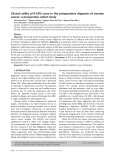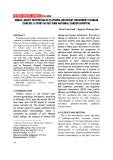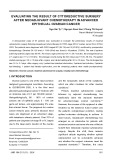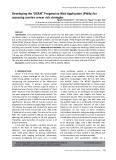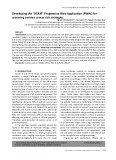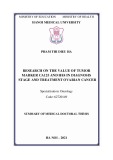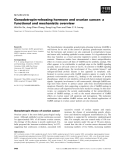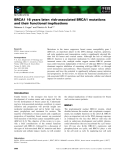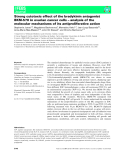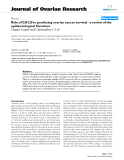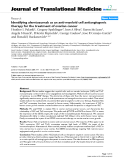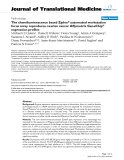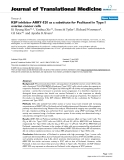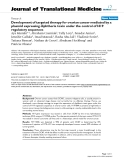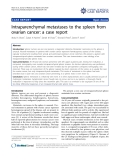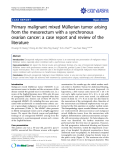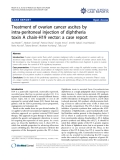
161
JOURNAL OF MEDICAL RESEARCH
JMR 184 E15 (11) - 2024
Corresponding author: Ngo Van Ty
Hanoi Medical University
Email: dr.ngovantyhmuh@gmail.com
Received: 12/09/2024
Accepted: 17/10/2024
I. INTRODUCTION
EVALUATING THE RESULT OF CYTOREDUCTIVE SURGERY
AFTER NEOADJUVANT CHEMOTHERAPY IN ADVANCED
EPITHELIAL OVARIAN CANCER
Ngo Van Ty1,, Nguyen Xuan Hau1, Phung Thi Huyen2
1Hanoi Medical University
2K Hospital
A retrospective study of 61 patients was conducted to evaluate the preliminary results of maximal
cytoreductive surgery following neoadjuvant chemotherapy for FIGO stage IIIC-IV ovarian cancer from 2019 to
2023. The patients were diagnosed with FIGO staged IIIC (54.1%) and IV (45.9%), confirmed by preoperative
histopathology. Elevated CA 125 level (> 1000 UI/ml) was found in 45 patients (73.8%). The rate of patients
achieving optimal surgery was 80.4%. The mean surgery time was 134.1 ± 39.1 minutes, the average blood loss
in 1 surgery was 171.2 ± 144.9mL. The drainage volume during the first 3 days was 115.4 ± 38.1mL. The patient
started passing gas 3.9 ± 1.0 days after surgery, and started walking after 8.3 ± 2.0 days. The discharged day
was 10.1 ± 2.1 days. After surgery, only 1 patient had intestinal obstruction, 2 patients had infection, 2 patients
had bleeding, 1 patient had bladder dysfunction, and the remaining patients were stable postoperatively.
Keywords: Ovarian cancer, maximal cytoreductive surgery, neoadjuvant chemotherapy.
Ovarian cancer is one of the most common
malignant gynecological conditions. According
to GLOBOCAN 2020, it is the third most
prevalent gynecological cancer in Vietnam, with
an incidence rate of 2.1 per 100,000 women.1
Histopathologically, 80 - 90% of ovarian
cancers are of epithelial origin, 5 - 10% are
germ cell tumors, and approximately 5% arise
from stromal tissue. The prognosis for ovarian
cancer remains poor, primarily because most
cases are diagnosed at an advanced stage,
with metastasis already present. Over 70% of
patients are diagnosed at stage III or IV, largely
due to the deep pelvic location of the ovaries
and the nonspecific nature of the symptoms,
which are often mistaken for other medical
conditions.2
Primary maximal cytoreductive surgery
followed by adjuvant chemotherapy has
traditionally been the standard treatment
for advanced-stage ovarian carcinoma.3,4
However, the success of this approach is often
hindered by the extensive tumor burden and
the patient’s compromised condition, making
optimal outcomes challenging to achieve. In
recent years, neoadjuvant chemotherapy has
emerged as an alternative for patients with
advanced ovarian carcinoma who are unlikely to
benefit from immediate maximal cytoreductive
surgery. Despite this shift, there remains
significant debate regarding whether optimal
cytoreduction can be consistently achieved
and whether the surgical outcomes meet the
expected standards.5-7 Therefore, this study





